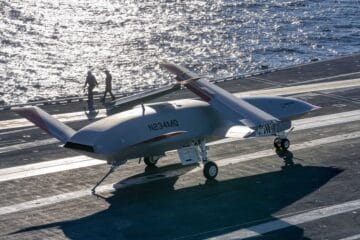NAVAIR press release
The Fire Scout program office, in conjunction with the Office of Naval Research (ONR), and Program Executive Office Unmanned and Small Combatants (PEO USC) have partnered with the Naval Air Warfare Center Aircraft Division’s (NAWCAD) AIRWorks, Aircraft Prototype Systems Division (APSD), Webster Outlying Field (WOLF), and Air Test and Evaluation Squadron Two Four (UX-24), to execute the final phase of the Single System Multi-Mission Airborne Mine Detection (SMAMD) Future Naval Capability Program.
SMAMD will be the first MCM system flown onboard the MQ-8C Fire Scout as well as the airframe’s heaviest payload carried to date. The SMAMD system, developed by BAE Systems, utilizes an airborne optical sensor suite that will have the ability to have real-time onboard processing coupled with low false alarm rates will enable the warfighter to respond swiftly to detected threats. Current MCM technologies require post-mission analysis that lengthens the threat detection and mitigation timeline.
“This capability is extremely important as we see future fights occurring in the littoral waters where mine warfare is prevalent. A mine warfare capability will greatly reduce risk for LCS and other vessels in the littoral.”
Capt. Thomas Lansley, Fire Scout Program Director
In February, UX-24 conducted Flying Qualities and Performance (FQ&P) testing with the MQ-8C using mass equivalency models in place of the prototype system pods, which mimic the size and weight of the SMAMD System. FQ&P testing is performed to collect data to allow for the evaluation of air vehicle performance and handling to assess the safety of flight assessment and airworthiness.

This spring the joint team will hold a land-based demonstration of the MCM prototype at the Naval Surface Warfare Center in Panama City, Florida. The demo will stretch from the beach zone, drifting mines and moored mines both in shallow water and deep water up to 10 kilometers offshore. The objective of the demonstration is to gather performance data for both the MQ-8C Fire Scout and SMAMD to inform future integration efforts.
The SMAMD will prove that a podded MCM system can operate as intended on the MQ-8C without causing adverse effects to the UAV or significantly diminishing time on station.
“The program office will continue to gather information to inform future integration efforts of the COBRA Block II System onto the MQ-8C,” said Lansley.
The MQ-8C Fire Scout is currently deployed aboard USS Milwaukee (LCS-5) to support operations in the U.S. 4th Fleet area of responsibility. Fire Scout delivers real-time intelligence, surveillance, reconnaissance and targeting (ISR &T) capabilities. It brings increased situational awareness to the fleet in distributed maritime operations, extending the ship’s sensors range and endurance.






